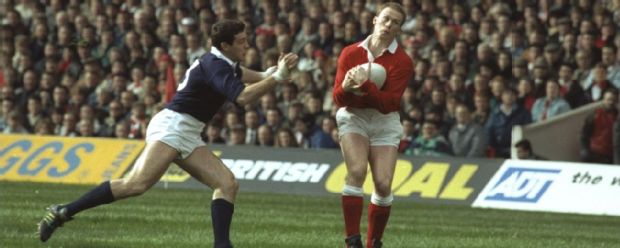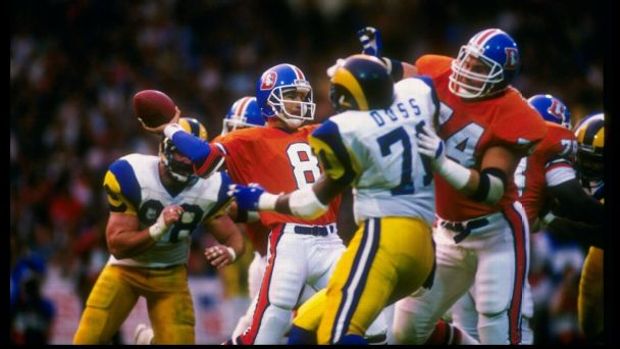|
Six Nations
Rewind to 1986: How Wales' Paul Thorburn booted himself towards a shot at the NFL
Huw Richards
February 12, 2016
 Paul Thorburn catches the ball© Russell Cheyne/Allsport When Wales played Scotland in Cardiff 30 years ago, it was 16-15 in the second half when Welsh outside-half Jonathan Davies, clearing just inside his own 22-metre line, was obstructed. The whistle went and the penalty was awarded on the left-hand side of the pitch, just before the Welsh 10-metre line. The crowd waited for the kick to touch that would surely follow. But Wales's fullback Paul Thorburn, speaking to skipper David Pickering, had other ideas. He later recalled: "I had told David Pickering that I would have a go and knew that if I missed, it would still leave play in the Scottish half." Veteran BBC commentator Bill MacLaren, who had seen most things in rugby, was incredulous. "You won't believe this ... it's miles to the goalposts ... this would be a monster," he told the TV audience. "What a belt he's given it", said MacLaren as the ball rose from Thorburn's boot and flew roughly in line with the left-hand post, to finally drop just inside the upright and, crucially, just over bar. "That is amazing. I've seen all the great goalkickers in the world over the last decade, but I've never seen anything like this." It was classic MacLaren, his excitement at seeing something remarkable on the pitch and unshakeable professional neutrality outweighing deeply felt loyalties as a Scot -- which were doubtless wounded since Scotland now trailed 19-15 in a match in which it had scored three tries to one. And we have seen nothing quite like it since. The length of the kick -- 64 metres, or just over 70 yards -- is usually cited as the longest in international rugby history. And while Paul Thorburn, then in only his second season of senior rugby -- never mind international -- would go on to captain Wales, play a significant part in many more memorable matches and retire in 1991 as Wales's highest points scorer (a record he was to lose to current holder Neil Jenkins), it remained the defining moment of his career. There is a certain irony in this. He didn't even think it was his best kick that day. His fifth and final penalty, sealing Wales's 22-15 win, was from halfway and into a swirling wind. "It certainly cleared the crossbar with much more to spare," he has recalled.  Quarterback Gary Kubiak of the Denver Broncos in action during the American Bowl game against the Los Angeles Rams at Wembley Stadium© Allsport /Allsport And there would be other kicks for higher stakes and under greater pressure. There was the conversion shot from the left hand touchline to take third place in the inaugural Rugby World Cup in 1987, and still more the final Triple Crown-sealing penalty against Ireland at Lansdowne Road in 1988. "So much was at stake and I hadn't kicked well," he said. Both went over, although success was not sealed against the Irish until Thorburn had also taken, as team-mate Ieuan Evans remembers "a crucial mark from a huge Garryowen with the entire Irish team screaming down on him". As Evans said, he was "rock solid when the chips were down". To Robert Jones he was "the ideal man to have around in a close match." But it is the long kick that everyone remembers. It might even have taken him out of rugby union, since it attracted the attention of Georgia Frontiere, owner of the Los Angeles Rams franchise in the NFL. Told by friends at London Welsh of Thorburn's feat, she was curious to know what he might achieve in her game. He was signed as a triallist when her Rams played in a pre-season game at Wembley against the Denver Broncos in August 1987. How serious either party was is open to doubt. The contract was for one match, and was a useful promotional gimmick for the American Bowl, an annual Wembley event which was beginning to lose its appeal after the American game's mid-80s peak in Britain. Thorburn took good care to make sure the terms and conditions did not affect his amateur status -- leeway he would certainly not have been permitted had he gone anywhere near even the most simon-pure amateur rugby league. It was not a roaring success. Thorburn admitted to finding the helmet disconcertingly heavy, rammed a conversion kick into the backside of a team-mate in practice and achieved only a drifting, loopy trajectory with a kick-off in the Wembley match. But it should not detract from a distinctive and distinguished career as both Wales' fullback of the latter half of the 1980s -- his 37 caps were sixth on its all-time list when he retired -- and with the Neath team which dominated club rugby. Controversy followed him. In part it was a mix of abilities that led the Welsh selectors to dispense with his defensive and kicking talents to include Tony Clement, a much more talented attacker, at the start of the 1988 Triple Crown. In part it was a temperament which was equal parts fire and ice.
Rupert Moon, teammate for a season at Neath, observed "an aloofness, a distance or business-like manner that cocooned him from a lot of people and players within the club". Yet he also had, as Ieuan Evans recalled, "an unfortunate habit of doing the wrong thing at the wrong time". As captain in 1989, he was visibly in floods of tears during the anthems before the England match, gestured violently to the press box after Wales's win and at the after-match banquet labelled Stephen Jones of the Sunday Times "the scum of the earth" for his criticism of Welsh performances that season. There were tears again, this time in the privacy of manager Clive Rowlands' room, as he quit both captaincy and international rugby at the end of Wales's abysmal tour of Australia in 1991, only a few months before that year's World Cup. But his intelligence -- he has a degree in microbiology from Swansea University, while admitting he was more interested in playing rugby than academic achievement at the time -- and business acumen have served him and the game well since. He was tournament director for the 1999 World Cup, hosted principally in Wales, then worked on the commercial side of first the WRU then the Ospreys, before setting up his own business development consultancy in 2010. Perhaps the most remarkable thing about the kick is that it remains the record. Kicking ranges have lengthened over the last 30 years with the shot from halfway -- see Jules Plisson's winning effort against Italy -- a routine achievement. Better pitches and equipment have contributed to that, and Thorburn was an early proponent of the kicking tee. But the real monster may have been done for by a rule-change (one of many borrowed from rugby league over the years) in the early 1990s. Previously, when a team kicked a penalty to touch, they faced the put-in at the subsequent line-out. Now they were able to kick to touch, and get the put-in as well. Had Pickering and Thorburn, already leading 16-15 and with time to go, had the option of what the French felicitously label the penaltouche in 1986, the odds must have been that the ball would have been boomed into touch, offering Wales a much better field position. And that, since the early 1990s, has been the percentage call when awarded a penalty 10 metres into your own half. It is possible to conceive of circumstances in which the record may be broken -- probably involving a team trailing by two points with time up, a following wind and a kicker capable of making the distance. But it will take something like that. © ESPN Sports Media Ltd.
|
Live Sports
Communication error please reload the page.
-
Football
-
Cricket
-
Rugby
-
- Days
- Hrs
- Mins
- Secs
F1 - Abu Dhabi GP
Abu Dhabi Grand Prix December 11-131. Max Verstappen ()
2. Valtteri Bottas (Mercedes)
3. Lewis Hamilton (Mercedes)
4. Alexander Albon ()
5. Lando Norris ()
6. Carlos Sainz Jr ()
-
ESPNOtherLive >>
Darts - Premier League
Golf - Houston Open
Snooker - China Open
Tennis - Miami Open

